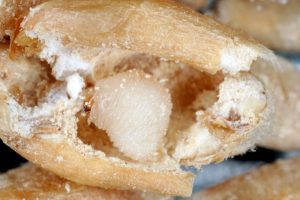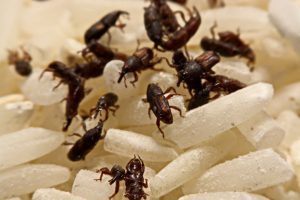HOW TO TRACK AND ELIMINATE FOOD WEEVILS
By Chris Williams on February 6, 2019.
What is a rice weevil? We found these little dark bugs in a bag of dried, colored corn that we bought at a farmers’ market. The local extension agent said they were rice weevils. So what were they doing in a bag of corn?
P. L., Swampscott, MA
Although entomologists give specific names to all of the various insects that infest stored foods, the flour beetle for example, isn’t limited to infesting flour. Old-timers used to refer to almost all food insects as “weevils,” and infested foods were considered “weevily.” Weevils are just one type of beetle that infests stored or packaged foods. The look-alike rice weevil and granary weevil are the primary weevil pests, and can be found in food products such as rice, dried corn, sorghum, wheat, birdseed, dried beans, and nuts. Granary weevils are better able to withstand cold temperatures than rice weevils and so may be more common in northern states.
WEEVILS DEVELOP INSIDE GRAINS OR KERNELS

Weevil larva inside damaged grain. Shutterstock.
The weevils are different from other food beetles because the larval form feeds and develops inside a single whole grain, rather than feeding on the outside of the grain or on processed grain or foods made from processed grains. Since weevils feed primarily on whole grains, they are less common in home kitchens than many other food beetles or moths that feed on flours or processed foods.
Weevils have a unique look, too, with a long extended “snout” bearing their mouthparts at the tip. They are brown, 1/8 to 1/4-inch long, with heavily pitted marks on the top of the thorax and abdomen. The rice weevil has four pale orange patches on the top of its back. The weevil larva, which is rarely seen since it is inside the grain, is a whitish grub. Once fully developed, the larva pupates inside the grain and chews its way out as an adult weevil. The rice weevil can fly and both rice and granary weevils will pull their legs up and play “possum” when disturbed.
In our region, rice weevils are usually pests in bulk grain storage but they, or their eggs, can show up in stored foods or packaged products. Since weevils are internal feeders in dried corn kernels, they can even be found in nonfood, decorative items such as Indian corn crafts or bean or grain mosaic pictures, or in ornamental wreaths with whole nuts, and the like.
FIND AND DISCARD THE INFESTED FOODS
Rice and granary weevils are controlled in the same manner as other stored food pests. First, you have to determine the source of the weevils and which food products in your kitchen or pantry are infested, or could become infested. This can be difficult since you won’t see evidence of the weevils in many cases until they begin to emerge from the grains when the damage is done. Besides the weevils themselves, you might see circular holes in the rice kernels or grains, or floury material that has sifted out of the grains. See How to Check Food Products for Insects – Advice From the Pros.

Weevils on rice. Shutterstock.
Bag up any infested, or presumed to be infested, foods or other items and throw them out. A weevil infestation in your kitchen is actually easier to eliminate than many other food pests since weevils have a more limited food range. Infestations are usually smaller and less likely to move into other products or packages. Getting rid of infested foods and washing down cabinet shelves will probably solve the problem.
If you’ve done all that and are still seeing weevils, either: (1) you missed an infested product (here’s a hint: weevils are sometimes found in dried fruit or in hard, caked flour), or (2) you have another food beetle infestation as well, or (3) the weevils are developing in a nonfood item (see above), or (4) weevils are coming from food or birdseed that has been hoarded by mice in a hidden place (see How Did Dog Food Get into a Wall Void? Think Mice).
Give Colonial Pest a call. We love solving pest mysteries!